17 April 1778 Friday
Vases, Candelabra, Grave Stones, Sarcophagi. Tripods, Lamps and Ancient Ornaments volume II
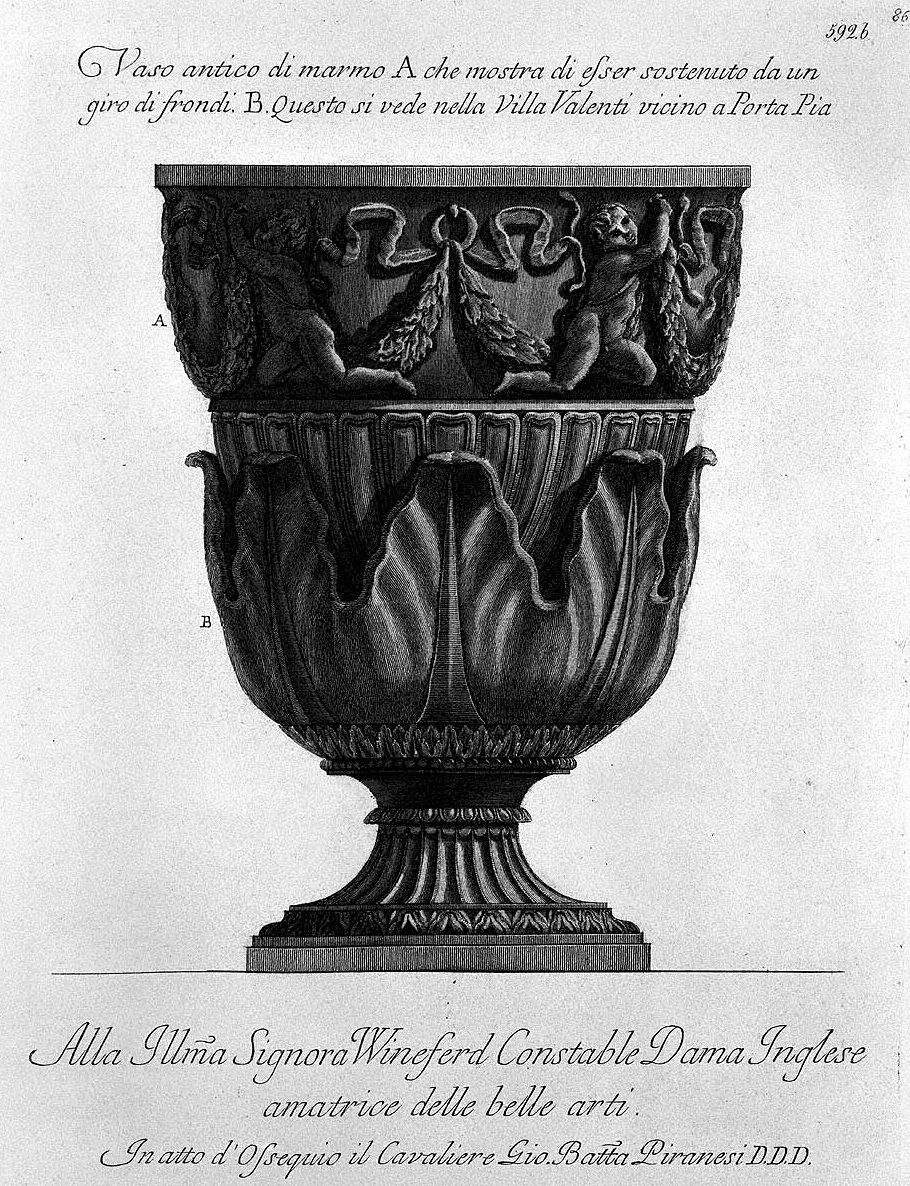
Ancient marble vase A which appears to be supported by a row of fronds B. This is seen in the Villa Valenti near Porta Pia
To the Most Illustrious Mrs. Wineferd Constable English Lady lover of the fine arts.
In deed of respect the Knight Gio. Batt(ist)a Piranesi D. D. D.
22-23 y.o. Francesco Piranesi 1781
Collezione delle piu belle statue di Roma
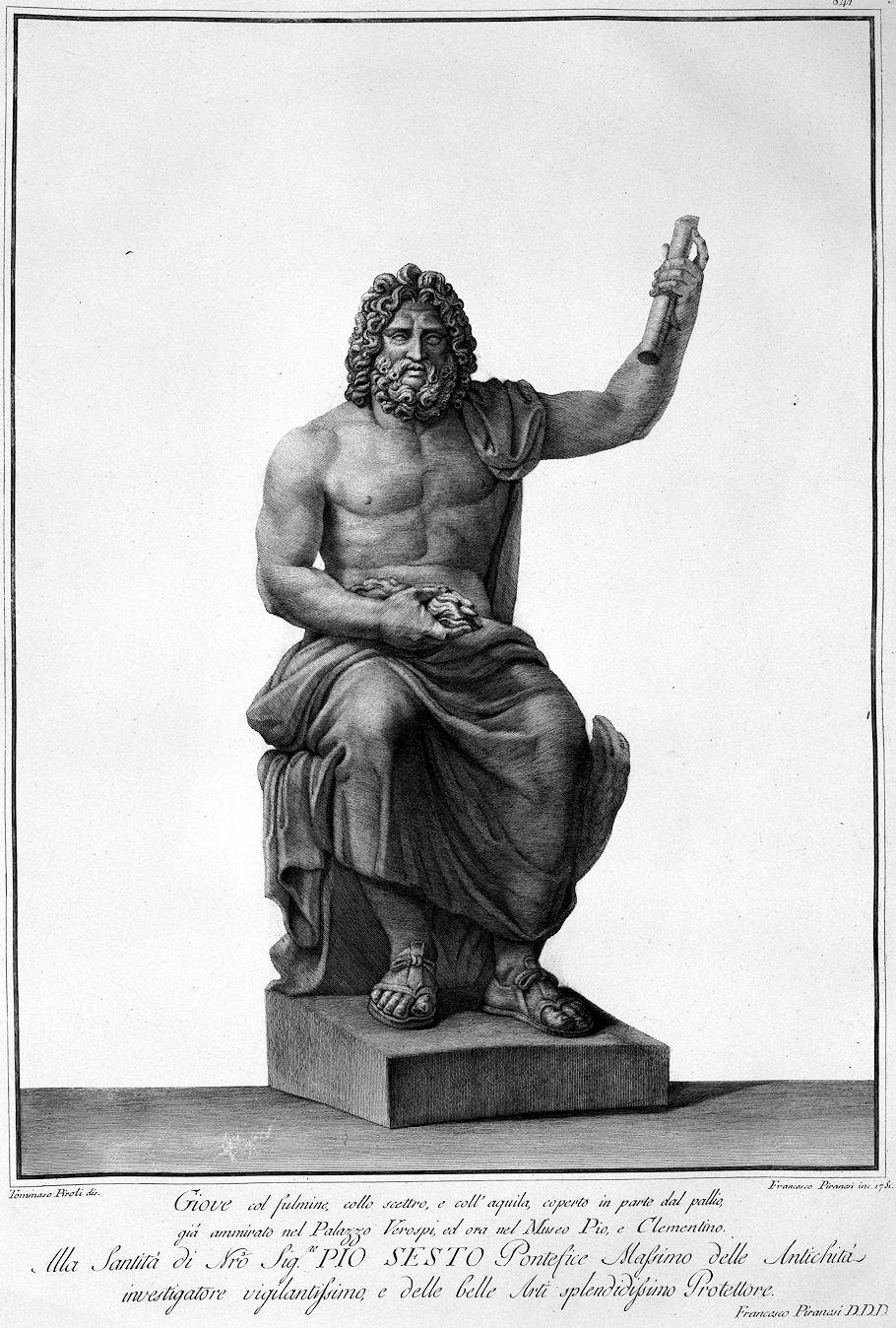
Jupiter with thunderbolt, scepter and eagle, partly covered by the pallium, formerly admired in the Verospi Palace, and now in the Pio and Clementino Museum.
To the Holiness of Nro. Sig.re PIO SIXTO Pontifex Maximus, most vigilant investigator of Antiquities, and most splendid Protector of the fine Arts.
Francesco Piranesi D.D.D.
Tommaso Piroli drawn Francesco Piranesi engraved 1781.
17 April 1812 Friday
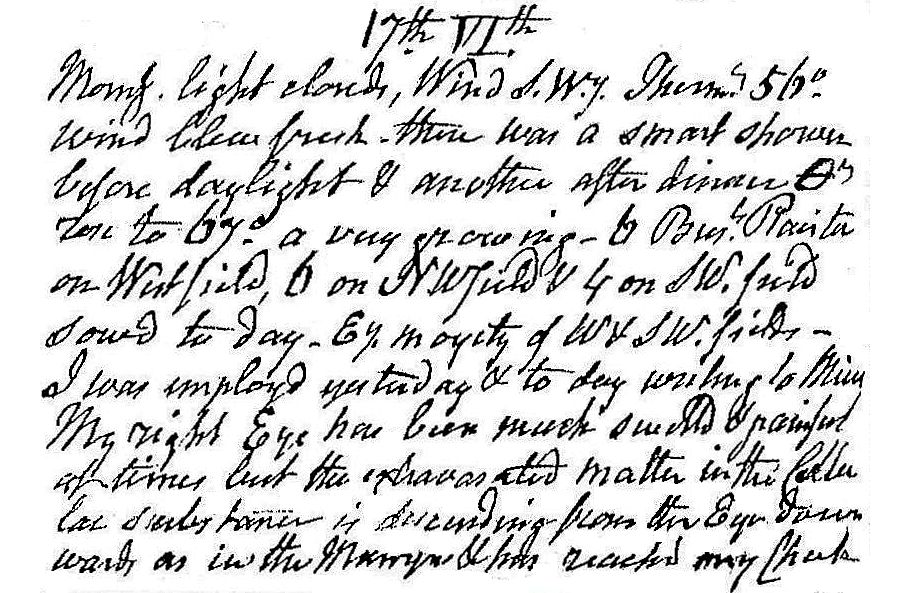
Morning light clouds, wind SWerly. Therm. 56°. Wind blew fresh, There was a smart shower before daylight and another after dinner. Temperature rose to 67°--a very growing--6 bushels planted[?] on west field, 6 on NW field and 4 on SW field sowed today. Ey. moyety[?] of W and SW fields.
I was employed yesterday and today writing to Miers. My right eye has been mush swelled and painful and painful at times, but the extravasated matter in the cellular substances is descending from the eye downwards as in the mumyn[?] and has reached my cheek.
17 April 1984
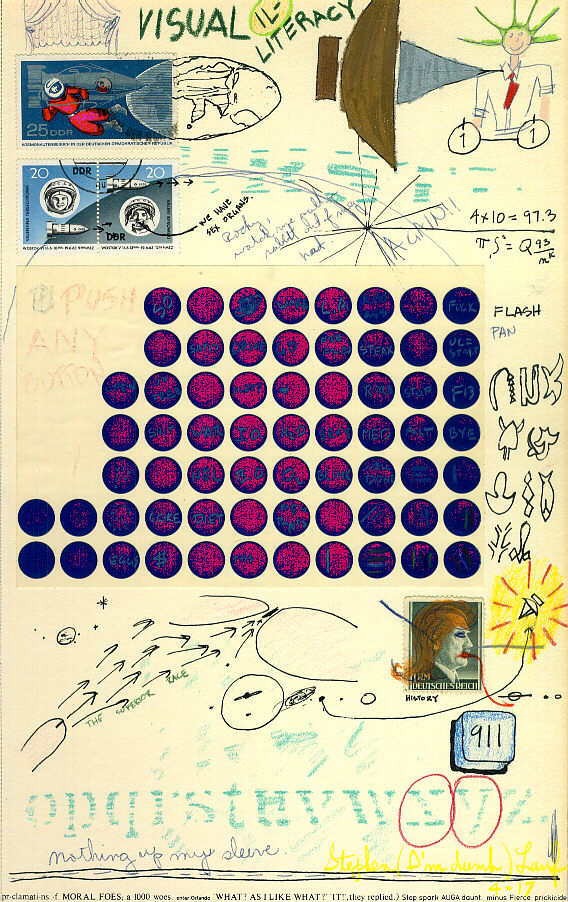
17 April 1998
the next four/five months
The work on the Ichnographia is well on its way... Besides the actual work on this project, it is becoming more and more clear that the methodology behind Piranesi's plan is very applicable to a rethinking of my own neighborhood. By that I mean that the Ashdale Valley, Rising Sun & Tabor, Cedar Grove, Tacony Creek, etc. all add up to a stimulating narrative, and can well be "drawn up" as an Ichnographia. This is where my Campo Marzio work and my Tacony Creek Park work overlap intellectually.
17 April 2005
lebbeus woods and Piranesi
...if you have found many similarities between Lebbeus Woods and Giovanni Battista Piranesi, name/illustrate them, because then you'll have found things that do not even exist.
Tafuri's take on Piranesi is indicative of inadequate research and a superficial ratiocination of Piranesi's oeuvre, and virtually everything Tafuri has written about the Ichnographia Campus Martius is plain wrong.
Piranesi's Carceri have engendered tortured perceptions of the ill-advised since their original printing. Find similarities between the Carceri and the Prima Parti di Architetture e Prospettive and you might start getting somewhere.
18 April gossip that matters?
the real gossip, however...
Constantine is Helena's second child, although the first and only with Constantius. Yes, Maximian and Helena were together beforehand, with a daughter, Theodora, as the result. In typical fashion, Maximian wanted more, i.e., a son, so he looked for another mate, while Helena and Constantius soon got together. Fortunately, Eutropia and Theodora bonded well, and the "secret" was mostly forgotten except by the inner few adults. Twenty years later the "secret" became even more secret as Constantius married Theodora, but it did ultimately matter that all Constantius' children were closely related to Helena, which also kind of explains why Crispus "got the short end of the stick." Alas, poor Fausta, it was her learning of the secret(s) that led to her suicide.
So who was Maxentius' real father?
Eutropia now says it's Diocletian, but that laugh while she says it still makes you wonder.
lebbeus woods and Piranesi
...please indicate where Tafuri is right about the Ichnographia Campus Martius. Of course, Tafuri didn't even know Piranesi printed two different versions of the Ichnographia Campus Martius, but why should that mean anything?
At the very beginning of The Sphere and the Labyrinth, Tafuri quotes from a text by Carlo Ginzburg and Adriano Prosperi:
"There comes a moment (though not always) in research when all the pieces begin to fall into place, as in a jig-saw puzzle, where all the pieces are near at hand and only one figure can be assembled (and thus the correctness of each move be determined immediately), in research only some of the pieces are available, and theoretically more than one figure can be made from them. In fact, there is always the risk of using, more or less consciously, the pieces of the jig-saw puzzle as blocks in a construction game. For this reason, the fact that everything falls into place is an ambiguous sign: either one is completely right or completely wrong. When wrong, we mistake for objective verification the selection and solicitation (more or less deliberate) of the evidence, which is forced to confirm the presuppositions (more or less explicit) of the research itself. The dog thinks it is biting the bone and is instead biting its own tail."
HOW IRONIC!
"So where is Tafuri now?"
"Why he's in the ether playground, just where he's always been."
lebbeus woods and Piranesi
Again, virtually everything Tafuri has written about Piranesi's Ichnographia Campus Martius is plain wrong, thus Tafuri's "particular interpretation relating Piranesi's work to the shaping of space by later avant-garde movements" is based on incorrect interpretation.
Interesting how 12 Monkeys was filmed in Philadelphia, but who cares. What's more interesting is the exact location of the History of Constantine tapestries vis-a-vis the "axis of life." ...you should get up on the latest gossip.
Do any of you ever stop to think and wonder why a superficial similarity between Lebbeus Woods' work and Piranesi's work is worthy of intellectual investigation, while a very real similarity between Philadelphia's Benjamin Franklin Parkway and a very symbolic aspect of Piranesi's Ichnographia Campus Martius is immediately scorned as worthless and/or fantasy? I think the answer lies within the direct relationship of ignorance and ignoring, plus the propaganda of the ether playground.
...just because you don't know about my delving into further details doesn't mean it hasn't already happened.
Oh, and what are the many similarities between Lebbeus Woods and Piranesi again?
lebbeus woods and Piranesi
Piranesi did a whole lot more than visually represent "improbable and imagined" spaces. Piranesi was primarily an ur-archaeologist, and his hands-on understanding of "history" manifests an unprecedented delineation of how history coalesces with (architectural) design. Even Piranesi's personal design history manifests a coalescence, e.g., Prima Parti di Architetture e Prospettive through the Carceri through the Osservazioni sopra la Lettre de M. Mariette through the Diverse Maniere d'Adornare i Cammini through the Vasi, Candelabri, Cippi. Is that what Lebbeus Woods does?
My authority and dominance is in the field of Piranesi's Ichnographia Campus Martius, but why should I tell you all I know for free?
...remember when you responded here at archinect on 22 January 2003 with:
Xavier Costa, in a class he taught at the AA while I was there, related it [the Ichnographia Campus Martius] to museological strategies/memory aids. Not sure that this is what you are asking, and I don't know if he ever published such a thing.
Could it be that Costa received his information from Marcel Baumgartner's "Topographie als Medium der Erinnerung in Piranesi's 'Campo Marzio dell' Antica Roma'"? published in 2000? Baumgartner at least admits/footnotes his knowledge of the Encyclopedia Ichnographica as published at www.quondam.com from 1 July 1998 to 20 March 2000.
17 April 2007
...and speaking of random tangents
there's a movie in there somewhere
Ever since learning about Helen Gregoroffsky Fisher, I've wanted to see The Europeans again (a movie I haven't seen in almost 30 years, and little did I know I was a Merchant/Ivory fan way back then). Henry James wrote the novel, and I want to read that soon, although Miers' journals probably draw a better picture. Anyway, I finally saw The Europeans again last night, and yes it all relates quite well. Now I envision a new movie, Learning from Helen Gregoroffsky Fisher.
17 April 2012
Why are we having this conversation?
Orhan, experience itself is a factor of getting good at participating in online discourse--I started back in 1997 when I subscribed to the archithestics (sp?) email list-serv. You have to write and keep on writing, and you have to write with conviction. Speaking personally, if I'm not just sharing something, then I'm probably aiming at critique. And, at best, the effect is not so much to make an all out change, rather to add to or somewhat shift or even clarify the overall perspective.
You also have to read a lot of what other people say.
17 April 2017
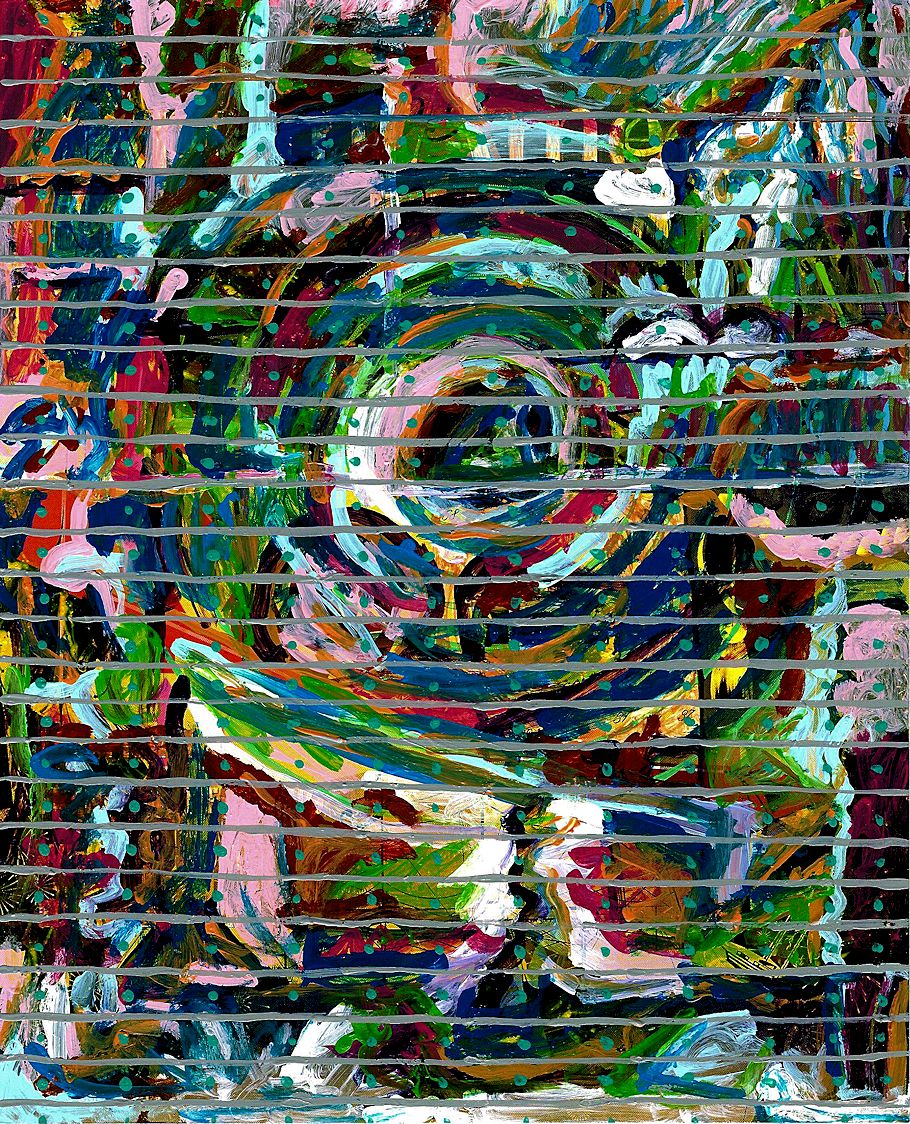
zero two two
17 April 2022

17 April 2023 Monday
Today's task was to compose a synopsis of Hélène Gregoroffsky Fisher's life, but that quickly got stuck by Miers Fisher's 1818 letter to Stephen Grellet:
1818.01.20
My Dear Friend
I have heard within some days past of thy having upon thy mind a prospect of paying a visit to the Capital of the Russian Empire during the course of the present year and yesterday had a confirmation of the Idea with this additional circumstances, that thou wouldst not depart until after the ensuing yearly meeting of New York in the 6th month. Upon first hearing this circumstance I felt a satisfaction in the hope that by thy means I could obtain some satisfactory account concerning the situation of my Daughter in Law Helen Gregoroffsky the widow of my deceased son Miers Fisher Jun., who died within 24 hours after the Marriage was celebrated, supposed of Apoplexy. There are some peculiar circumstances relating to the connection which I would wish to communicate to thee. If thou should go to Petersburgh, It would seem unpardonable by her I should permit a friend of thy standing personal[ly] know[n] to me, to go to the place of her residence wholly unacquainted with circumstances so interesting to so near a connection as between Father and Daughter in Law and the want of confidential information respecting her has hitherto prevented my giving her an invitation to visit the friends of her deceased husband in America. Her character handed to me by several persons to whom she was known has been amiable and I have no reason to doubt that she was of respectable parentage and connection, but her mode of Education was so very different from my family and friends that I feared we could not render her happy in a country far distant from her friends, her manner and her habits without yielding to her more of our own than I thought consistent with our profession and mode of living. It would be difficult to convey to thee in writing all my feelings upon this Interesting subject, but if I conjecture right that thou will think it proper and convenient for thee to spend a few days in Philadelphia before thy departure I shall esteem it a particular favor to be permitted to communicate to thee verbally some letters and papers with observations on them and to make thee the medium of conveyance to her of my best wishes for her welfare and happiness and of a qualified invitation to her to pay us a visit in case thou shouldst think after conversing with her consanguineous friends, thou should think such a measure would contribute to her happiness and our comfort--I should be pleased to have a line from thee expressive of the possibility of thy coming hither before thy voyage to Europe and am with my best desires for thy Peace and ..... in thy arduous undertaking and a safe return to thy amiable family.
Thy affectionate friend
Not till hours later did I come to realize what I had learned hours earlier: The Miers Fisher I've come to know through his 1812 almanac journal, the good natured, honest man, the man who had a wonderful (and even presently relatable) gift for describing daily events in few yet choice words, is perhaps, nevertheless, also the Miers Fisher that very few people actually knew.
The letter to Stephen Grellet instantly brought to mind what John Adams (first Vice President and second President of the United States) wrote in his diary 44 years earlier:
1774 SEPTR. 7. WEDNESDAY.
Dined with Mr. Miers Fisher, a young Quaker and a Lawyer. We saw his Library, which is clever.
But this plain Friend, and his plain, tho pretty Wife, with her Thee's and Thou's, had provided us the most Costly Entertainment. Ducks, Hams, Chickens, Beef, Pigg, Tarts, Creams, Custards, Gellies, fools, Trifles, floating Islands, Beer, Porter, Punch, Wine and a long &c.
We had a large Collection of Lawyers, at Table. Mr. Andrew Allen, the Attorney General, a Mr. Morris, the Prothonotary, Mr. Fisher, Mr. McKean, Mr. Rodney--besides these We had Mr. Reed, Govr. Hopkins and Governor Ward.
We had much Conversation upon the Practice of Law, in our different Provinces, but at last We got swallowed up, in Politicks...
Miers Fisher, too, had lived a life of double theater (facades); certainly not the same double theater as Piranesi's (who indeed created his entirely own stratosphere of double theater), but still a double theater life that the true first moderns found discreditable as too close to pretense and not close enough to reality.
14 January 2023
There is a correlation between Piranesi's discovery of the most refined ancient Roman circus plan and Francesco's presence at the beginning of modern archaeology--a sort of one hand washes the other. In a very real sense, it was the refinement that Francesco brought to field survey work that engendered Piranesi's late discovery in the first place. Their styles of field survey work differed for sure: the father rendering the actual as double theater while the son rendered the actual as real.
1803-04
Miers Fisher had been my father's trusted agent for about eighteen years, and the old gentlemen entertained great mutual friendship; indeed it would seem that Mr. Fisher was actually desirous that I should become a member of his family, and this was evinced within a few days by the manner in which the good Quaker presented me to a daughter of no mean appearance, but toward whom I happened to take an unconquerable dislike. [Lydia Fisher was 16 years old 9 February 1804. She eventually married Benjamin Warner.] Then he was opposed to music of all descriptions, as well as to dancing, could not bear me to carry a gun, or fishing-rod, and, indeed, condemned most of my amusements. All these things were difficulties toward accomplishing a plan which, for aught I know to the contrary, had been premeditated between him and my father, and rankled the heart of the kindly, if somewhat strict Quaker. They troubled me much also; at times I wished myself anywhere but under the roof of Miers Fisher, and at least I reminded him that it was his duty to install me on the estate to which my father had sent me.
One morning, therefore, I was told that the carriage was ready to carry me there, and toward my future home he and I went. You are too well acquainted with the position of Mill Grove for me to allude to that now; suffice it to say that we reached the former abode of my father about sunset. I was presented to our tenant, William Thomas, who also was a Quaker, and took possession under certain restrictions, which amounted to my not receiving more than enough money per quarter than was considered sufficient for the expenditure of a young gentleman.
Miers Fisher left me the next morning, and after him went my blessings, for I thought his departure a true deliverance; yet this was only because our tastes and educations were so different, for he certainly was a good and learned man."
John James Audubon, "Myself" in Audubon and His Journals (New York: Charles Scribner's Sons, 1897), pp. 15-17.
|